The maiden voyage of SpaceX’s Falcon 1 rocket started well, but then went sour moments after launch. Onboard cameras, broadcast live to the Internet showed the rocket rolling almost immediately and then the connection was cut. Company founder, Elon Musk, later commented that Falcon 1 managed about 1 minute of powered flight. The rocket was carrying a small satellite for the US Air Force called FalconSat-2, which would have investigated space weather.
Microscopic Tunnels Carved by Martian Microbes?
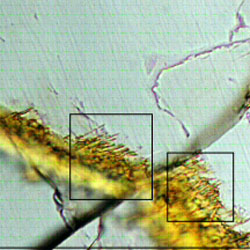
A thin slice of the Nakhla meteor. Image credit: OSU Click to enlarge.
Bacteria seem to live anywhere there’s water. One class of bacteria are known to burrow through igneous rock feeding on iron and other chemicals, and leaving a tiny tunnel behind them. Now researchers have found similar tunnels in a meteorite believed to have originated on Mars called the Nakhla meteorite. This adds additional data to the mounting evidence that Mars was wet in the distant past, and gives the tantalizing possibility that it was inhabited with life.
A new study of a meteorite that originated from Mars has revealed a series of microscopic tunnels that are similar in size, shape and distribution to tracks left on Earth rocks by feeding bacteria.
And though researchers were unable to extract DNA from the Martian rocks, the finding nonetheless adds intrigue to the search for life beyond Earth.
Results of the study were published in the latest edition of the journal Astrobiology.
Martin Fisk, a professor of marine geology in the College of Oceanic and Atmospheric Sciences at Oregon State University and lead author of the study, said the discovery of the tiny burrows do not confirm that there is life on Mars, nor does the lack of DNA from the meteorite discount the possibility.
“Virtually all of the tunnel marks on Earth rocks that we have examined were the result of bacterial invasion,” Fisk said. “In every instance, we’ve been able to extract DNA from these Earth rocks, but we have not yet been able to do that with the Martian samples.
“There are two possible explanations,” he added. “One is that there is an abiotic way to create those tunnels in rock on Earth, and we just haven’t found it yet. The second possibility is that the tunnels on Martian rocks are indeed biological in nature, but the conditions are such on Mars that the DNA was not preserved.”
More than 30 meteorites that originated on Mars have been identified. These rocks from Mars have a unique chemical signature based on the gases trapped within. These rocks were “blasted off” the planet when Mars was struck by asteroids or comets and eventually these Martian meteorites crossed Earth’s orbit and plummeted to the ground.
One of these is Nakhla, which landed in Egypt in 1911, and provided the source material for Fisk’s study. Scientists have dated the igneous rock fragment from Nakhla – which weighs about 20 pounds – at 1.3 billion years in age. They believe that the rock was exposed to water about 600 million years ago, based on the age of clay found inside the rocks.
“It is commonly believed that water is a necessary ingredient for life,” Fisk said, “so if bacteria laid down the tunnels in the rock when the rock was wet, they may have died 600 million years ago. That may explain why we can’t find DNA – it is an organic compound that can break down.”
Other authors on the paper include Olivia Mason, an OSU graduate student; Radu Popa, of Portland State University; Michael Storrie-Lombardi, of the Kinohi Institute in Pasadena, Calif.; and Edward Vicenci, from the Smithsonian Institution.
Fisk and his colleagues have spent much of the past 15 years studying microbes that can break down igneous rock and live in the obsidian-like volcanic glass. They first identified the bacteria through their signature tunnels then were able to extract DNA from the rock samples – which have been found in such diverse environments on Earth as below the ocean floor, in deserts and on dry mountaintops.
They even found bacteria 4,000 feet below the surface in Hawaii that they reached by drilling through solid rock.
In all of these Earth rock samples that contain tunnels, the biological activity began at a fracture in the rock or the edge of a mineral where the water was present. Igneous rocks are initially sterile because they erupt at temperatures exceeding 1,000 degrees C. – and life cannot establish itself until the rocks cool. Bacteria may be introduced into the rock via dust or water, Fisk pointed out.
“Several types of bacteria are capable of using the chemical energy of rocks as a food source,” he said. “One group of bacteria in particular is capable of getting all of its energy from chemicals alone, and one of the elements they use is iron – which typically comprises 5 to 10 percent of volcanic rock.”
Another group of OSU researchers, led by microbiologist Stephen Giovannoni, has collected rocks from the deep ocean and begun developing cultures to see if they can replicate the rock-eating bacteria. Similar environments usually produce similar strains of bacteria, Fisk said, with variable factors including temperature, pH levels, salt levels, and the presence of oxygen.
The igneous rocks from Mars are similar to many of those found on Earth, and virtually identical to those found in a handful of environments, including a volcanic field found in Canada.
One question the OSU researchers hope to answer is whether the bacteria begin devouring the rock as soon as they are introduced. Such a discovery would help them estimate when water – and possibly life – may have been introduced on Mars.
Original Source: OSU News Release
A Nearby Twin of the Sun
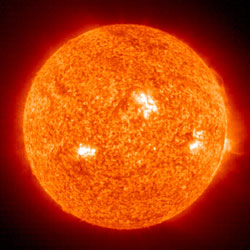
HD98618 would look almost identical to our Sun. Image credit: SOHO Click to enlarge.
When astronomers start searching for evidence of live orbiting other stars, they’ll start with familiar terrain: other stars like our Sun. Astronomers from the Australian National University have identified a nearby candidate that’s a virtual twin of our Sun in age, size, temperature and chemistry; although, it’s 2% more massive. The star, HD98618, is located 126 light-years away in the constellation Ursa Major (the Big Dipper), and is bright enough to see with binoculars.
ANU astronomers have discovered a nearby solar twin which may shed light on the search for planets that are similar to Earth and that may even support life.
HD98618 is only the second star found so far that is almost identical to the Sun in age, size, temperature and chemistry, according to the researchers Dr Jorge Meléndez, Ms Katie Dodds-Eden and Mr José Robles, from the Research School of Astronomy and Astrophysics.
“This solar twin doesn’t only have the same mass as the Sun, it was also formed with the same ‘chemical recipe’. So this star was equipped in the same way as the Sun to form Earth-like planets,” Mr Robles said.
“Hopefully, as new planet finding techniques are developed and refined, astronomers will find whether HD98618 hosts terrestrial planets, which may even contain life.”
HD98618 lies a mere 126 light-years away in the northern constellation of Ursa Major (the ‘Big Dipper’). It is bright enough to see in binoculars, but only in the Northern Hemisphere.
The researchers believe that HD98618 is about four billion years-old, about 10 per cent younger than our own Sun. Its chemical properties are almost identical to the Sun and to the other closest Sun twin, a star known as 18 Scorpii, which was discovered a decade ago.
“It means that hypothetical terrestrial planets around this solar twin may have had enough time to develop some kind of complex life, assuming the time-scale for complex life formation is similar to Earth’s,” Dr Meléndez said.
The team says that focused observations of the two stars by planet-hunter teams could reveal or rule out within a few years giant planets, such as our own Jupiter, around HD98618. “18 Scorpii and HD98618 offer hope to find solar systems similar to our own in the Universe,” Dr Meléndez said.
The discovery also has implications for research in other areas. Solar twins are ideal for the absolute calibration of astronomical measuring instruments. They can provide data useful in modelling the solar phenomena that may affect climate change, and will help settle the argument about the uniqueness or otherwise of our Sun and Solar System.
“We had a number of candidates with similar properties to the Sun, but while we held out hope for each star that it would turn out to be really special, it was not at all certain to happen. HD 98618 was one of the last of our candidates to be analysed, so it was quite a surprise when we discovered how it stood out from the other candidates, together with 18 Scorpii. It was very exciting – I had to blink twice to be sure I wasn’t imagining it,” Ms Dodds-Eden said.
The researchers made the discovery using the largest telescope in the world, the 10m Keck I telescope on the summit of Hawaii’s dormant Mauna Kea volcano.
Their paper detailing the discovery will be published in Astrophysical Journal Letters. Related images are available from the ANU Media Office.
Original Source: ANU News Release
First Photo from Mars Reconnaissance Orbiter
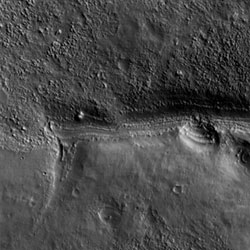
A portion of the first full-resolution image returned by MRO. Image credit: NASA/JPL. Click to enlarge.
After years of development and months of spaceflight, NASA’s Mars Reconnaissance Orbiter is beginning to return photos of the Red Planet. The spacecraft pointed three of its cameras at the surface of Mars on Thursday, and started snapping pictures. This photo was taken when the spacecraft was at an altitude of 2,489 kilometers (1,547 miles), which is about 9 times as high as its final orbit – the pictures are going to just get better. Even so, the resolution at this altitude is about the same as the best pictures returned by other Mars orbiters.
The first test images of Mars from NASA’s newest spacecraft provide a tantalizing preview of what the orbiter will reveal when its main science mission begins next fall.
Three cameras on NASA’s Mars Reconnaissance Orbiter were pointed at Mars at 8:36 p.m. PST Thursday, while the spacecraft collected 40 minutes of engineering test data. The cameras are the High Resolution Imaging Science Experiment, the Context Camera and the Mars Color Imager.
“These high-resolution images of Mars are thrilling, and unique given the early morning time-of-day. The final orbit of Mars Reconnaissance Orbiter will be over Mars in the mid-afternoon, like Mars Global Surveyor and Mars Odyssey,” said Alfred McEwen, University of Arizona, Tucson, principal investigator for the orbiter’s High Resolution Imaging Science Experiment camera.
“These images provide the first opportunity to test camera settings and the spacecraft’s ability to point the camera with Mars filling the instruments’ field of view,” said Steve Saunders, the mission’s program scientist at NASA Headquarters. “The information learned will be used to prepare for the primary mission next fall.” The main purpose of these images is to enable the camera team to develop calibration and image-processing procedures such as the precise corrections needed for color imaging and for high-resolution surface measurements from stereo pairs of images.
To get desired groundspeeds and lighting conditions for the test images, researchers programmed the cameras to shoot while the spacecraft was flying about 2,489 kilometers (1,547 miles) or more above Mars’ surface, about nine times the range planned for the orbiter’s primary science mission. Even so, the highest resolution of about 2.5 meters (8 feet) per pixel – an object 8 feet in diameter would appear as a dot — is comparable to some of the best resolution previously achieved from Mars orbit.
Further processing of the images during the next week or two is expected to combine narrow swaths into broader views and show color in some portions.
The Mars Reconnaissance Orbiter has been flying in elongated orbits around Mars since it entered orbit on March 10. Every 35 hours, it has swung about 44,000 kilometers (27,000 miles) away from the planet then come back within about 425 kilometers (264 miles) of Mars’ surface.
Mission operations teams at NASA’s Jet Propulsion Laboratory, Pasadena, Calif, and at Lockheed Martin Space Systems, Denver, continue preparing for aerobraking. That process will use about 550 careful dips into the atmosphere during the next seven months to shrink the orbit to a near-circular shape less than 300 kilometers (200 miles) above the ground.
More than 25 gigabits of imaging data, enough to nearly fill five CD-ROMs, were received through NASA’s Deep Space Network station at Canberra, Australia, and sent to JPL. They were made available to the camera teams at the University of Arizona Lunar and Planetary Laboratory and Malin Space Science Systems, San Diego, Calif.
Preliminary images from the High Resolution Imaging Science Experiment and additional information about the Mars Reconnaissance Orbiter are available online at: http://www.nasa.gov/mro or http://HiRISE.lpl.arizona.edu
Additional processing has begun for release of other images from the test in coming days.
For information about NASA and agency programs on the Web, visit: http://www.nasa.gov
JPL, a division of the California Institute of Technology in Pasadena, manages the Mars Reconnaissance Orbiter for NASA’s Science Mission Directorate, Washington. Lockheed Martin Space Systems is the prime contractor for the project and built the spacecraft.
Original Source: NASA/JPL News Release
Quasar Ignition in the Distant Universe
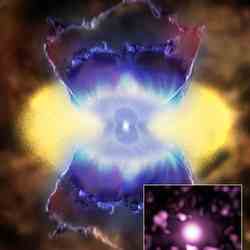
An illustration showing a quasar at the center of the galaxy. Image credit: NASA Click to enlarge
Sometimes the supermassive black holes at the hearts of galaxies are quiet, and nearly invisible. Other times they’re actively gobbling up material, blazing as quasars in the X-ray spectrum. NASA’s Chandra X-Ray Observatory has observed one of these transition times, when the heated material around the supermassive black hole is beginning to ignite. It’s likely the galaxy recently collided or merged with another galaxy, and the turbulence caused material to fall into the black hole.
An artist’s illustration depicts a quasar in the center of a galaxy that has turned on and is expelling gas at high speeds in a galactic superwind. Clouds of hot, X-ray producing gas detected by Chandra around the quasars 4C37.43 and 3C249.1, provide strong evidence for such superwinds.
The X-ray features seen at five, six, ten and eleven o’clock in the 4C37.43 image are located tens of thousands of light years from the central supermassive black hole that powers the quasar. They are likely due to shock waves in the superwind.
Mergers of galaxies are a possible cause for the ignition, or turn-on, of quasars. Computer simulations show that a galactic merger drives gas toward the central region where it triggers a burst of star formation and provides fuel for the growth of a central black hole.
The inflow of gas into the black hole releases tremendous energy, and a quasar is born. The power output of the quasar dwarfs that of the surrounding galaxy and pushes gas out of the galaxy in a galactic superwind.
Over a period of about 100 million years, the superwind will drive most of the gas away from the central regions of the galaxy, quenching both star formation and further supermassive black hole growth. The quasar phase will end and the galaxy will settle down to a relatively quiet life.
Original Source: Chandra X-ray Observatory
Comets May Be the Source of Earth’s Water
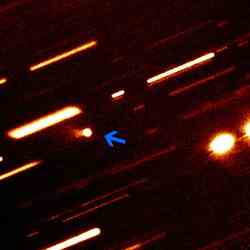
The new comet is indicated by the blue arrow. Image credit: Gemini Observatory Click to enlarge
Astronomers have discovered three icy comets that may help explain how the Earth’s oceans formed. These new comets have asteroid-like orbits, and formed in the warm inner Solar System, not in the outer reaches like most comets. This lends evidence to the theory that the main asteroid belt isn’t bone dry, as previously believed, but is actually quite rich in ice – a major source of our planet’s water.
Three icy comets orbiting among the rocky asteroids in the main asteroid belt between Mars and Jupiter may hold clues to the origin of Earth’s oceans.
The newly discovered group of comets, dubbed “main-belt comets” by University of Hawaii graduate student Henry Hsieh and Professor David Jewitt, has asteroid-like orbits and, unlike other comets, appears to have formed in the warm inner solar system inside the orbit of Jupiter rather than in the cold outer solar system beyond Neptune.
The existence of these main-belt comets suggests that asteroids and comets are much more closely related than previously thought and supports the idea that icy objects from the main asteroid belt could be a major source of Earth’s present-day water. This work appears in the March 23 edition of Science Express (pdf) and will also appear in an April print edition of Science.
The crucial observations were made on November 26, 2005, using the 8-meter Gemini North Telescope on Mauna Kea. Hsieh and Jewitt found that an object designated as Asteroid 118401 was ejecting dust like a comet. Together with a mysterious comet (designated 133P/Elst-Pizarro) known for almost a decade but still poorly understood, and another comet (designated P/2005 U1) discovered by the Spacewatch project in Arizona just a month earlier, “Asteroid” 118401 forms an entirely new class of comets.
“The main-belt comets are unique in that they have flat, circular, asteroid-like orbits, and not the elongated, often tilted orbits characteristic of all other comets,” said Hsieh. “At the same time, their cometary appearance makes them unlike all other previously observed asteroids. They do not fit neatly in either category.”
In both 1996 and 2002, the “original” main-belt comet, 133P/Elst-Pizarro (named after its two discoverers), was seen to exhibit a long dust tail typical of icy comets, despite having the flat, circular orbit typical of presumably dry, rocky asteroids. As the only main-belt object ever observed to take on a cometary appearance, however, 133P/Elst-Pizarro’s true nature remained controversial. Until now.
“The discovery of the other main-belt comets shows that 133P/Elst-Pizarro is not alone in the asteroid belt,” Jewitt said. “Therefore, it is probably an ordinary (although icy) asteroid, and not a comet from the outer solar system that has somehow had its comet-like orbit transformed into an asteroid-like one. This means that other asteroids could have ice as well.”
The Earth is believed to have formed hot and dry, meaning that its current water content must have been delivered after the planet cooled. Possible candidates for supplying this water are colliding comets and asteroids. Because of their large ice content, comets were leading candidates for many years, but recent analysis of comet water has shown that comet water is significantly different from typical ocean water on Earth.
Asteroidal ice may give a better match to Earth’s water, but until now, any ice that the asteroids may have once contained was thought to either be long gone or so deeply buried inside large asteroids as to be inaccessible for further analysis. The discovery of main-belt comets means that this ice is not gone and is still accessible (right on the surfaces of at least some objects in the main belt, and at times, even venting into space). Spacecraft missions to the main-belt comets could provide new, more detailed information on their ice content and in turn give us new insight into the origin of the water, and ultimately life, on Earth.
As conventionally defined, comets and asteroids are very different. Both are objects a few to a few hundred miles across that orbit throughout our solar system. Comets, however, are thought to originate in the cold outer solar system and consequently contain much more ice than the asteroids, most of which are thought to have formed much closer to the Sun in the asteroid belt between Mars and Jupiter.
Comets also have large, elongated orbits and thus experience wide temperature variations. When a comet approaches the Sun, its ice heats up and sublimates (changes directly from ice to gas), venting gas and dust into space, giving rise to a tail and a distinctive fuzzy appearance. Far from the Sun, sublimation stops, and any remaining ice stays frozen until the comet’s next pass close to the Sun. In contrast, objects in the asteroid belt have essentially circular orbits and are expected to be mostly baked dry of ice by their confinement to the inner solar system. Essentially, they should be just rocks. With the discovery of the main-belt comets, we now know this is not the case, and that, in general, the conventional definitions of comets and asteroids are in need of refinement.
This work is supported by a grant from the NASA Planetary Astronomy Program of the Science Mission Directorate.
More information: http://www.ifa.hawaii.edu/~hsieh/mbcs.html
Original Source: University of Hawaii
Dead Star Cores Surrounded in Superhot Gas
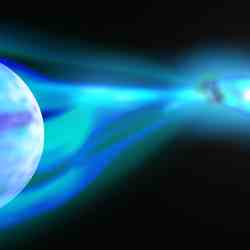
A hot gas cloud whirling around a miniature ‘cannibal’ star. Image credit: ESA Click to enlarge
ESA’s XMM-Newton space telescope has observed the tiny cores of dead stars wrapped up in a nice warm blanket of superheated gas. These “low-mass X-ray binary” are pulling a steady stream of material from a larger companion star, and then whipping it up into a disk. This observation answers the question of why these dead stars sometimes blink off in the X-ray spectrum. That’s the time when we’re seeing this disk edge-on, and it’s obscuring our view of the star.
ESA’s XMM-Newton has seen vast clouds of superheated gas, whirling around miniature stars and escaping from being devoured by the stars’ enormous gravitational fields – giving a new insight into the eating habits of the galaxy’s ‘cannibal’ stars.
The clouds of gas range in size from a few hundred thousand kilometres to a few million kilometres, ten to one hundred times larger than the Earth. They are composed of iron vapour and other chemicals at temperatures of many millions of degrees.
“This gas is extremely hot, much hotter than the outer atmosphere of the Sun,” said Maria Diaz Trigo of ESA’s European Science and Technology Research Centre (ESTEC), who led the research.
ESA’s XMM-Newton x-ray observatory made the discovery when it observed six so-called ‘low-mass X-ray binary’ stars (LMXBs). The LMXBs are pairs of stars in which one is the tiny core of a dead star.
Measuring just 15?20 kilometres across and comparable in size to an asteroid, each dead star is a tightly packed mass of neutrons containing more than 1.4 times the mass of the Sun.
Its extreme density generates a powerful gravitational field that rips gas from its ‘living’ companion star. The gas spirals around the neutron star, forming a disc, before being sucked down and crushed onto its surface, a process known as ‘accretion’.
The newly discovered clouds sit where the river of matter from the companion star strikes the disc. The extreme temperatures have ripped almost all of the electrons from the iron atoms, leaving them carrying extreme electrical charges. This process is known as ‘ionisation’.
The discovery solves a puzzle that has dogged astronomers for several decades. Certain LMXBs appear to blink on and off at X-ray wavelengths. These are ‘edge-on’ systems, in which the orbit of each gaseous disc lines up with Earth.
In previous attempts to simulate the blinking, clouds of low-temperature gas were postulated to be orbiting the neutron star, periodically blocking the X-rays. However, these models never reproduced the observed behaviour well enough.
XMM-Newton solves this by revealing the ionised iron. “It means that these clouds are much hotter than we anticipated,” said Diaz. With high-temperature clouds, the computer models now simulate much better the dipping behaviour.
Some 100 known LMXBs populate our galaxy, the Milky Way. Each one is a stellar furnace, pumping X-rays into space. They represent a small-scale model of the accretion thought to be taking place in the very heart of some galaxies. One in every ten galaxies shows some kind of intense activity at its centre.
This activity is thought to be coming from a gigantic black hole, pulling stars to pieces and devouring their remains. Being much closer to Earth, the LMXBs are easier to study than the active galaxies.
“Accretion processes are still not well understood. The more we understand about the LMXBs, the more useful they will be as analogues to help us understand the active galactic nuclei,” says Diaz.
Original Source: ESA Portal
Our Brown Dwarf Neighbour
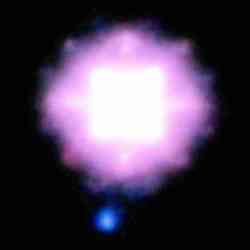
An image of the cool brown dwarf orbiting a star near the Sun. Image credit: UA Steward Observatory. Click to enlarge
Astronomers have discovered a brown dwarf in our galactic neighbourhood, only 12.7 light years away – this makes it the second closest brown dwarf ever discovered. The failed star is circling another star that was only recently discovered in the southern constellation Pavo. The primary star is small, with only 1/10th the mass of our Sun, and the brown dwarf orbits at 4.5 times the distance of the Earth to the Sun.
Astronomers have discovered a unique “brown dwarf” right in our solar neighborhood.
If your city were the galaxy, it would be like finding someone you didn’t know about living upstairs in your house, one of the discoverers said.
The rare object is only 12.7 light years from Earth, circling a primary star that itself was discovered only recently in the southern hemisphere constellation Pavo (the Peacock).
Only one other brown dwarf system has been found closer to Earth, and it’s only marginally closer.
The primary star is only one-tenth the mass of our sun. This is the first time astronomers have found a cool brown dwarf companion to such a low-mass star. Until now, none has been found orbiting stars less than half the mass of our sun.
The brown dwarf is 4.5 AU from the star, or four and one-half times farther from its star than Earth is from our sun. Astronomers estimate that the brown dwarf is between nine and 65 times as massive as Jupiter.
Brown dwarfs are neither planets nor stars. They are dozens of times more massive than our solar system’s largest planet, Jupiter, but too small to be self-powered by hydrogen fusion like stars.
Only about 30 similarly cool brown dwarfs have been found anywhere in the sky, and only about 10 have been discovered orbiting stars.
“Besides being extremely close to Earth and in orbit around a very low-mass star, this object is a ‘T dwarf ‘ – a very cool brown dwarf with a temperature of about 750 degrees Celsius (1,382 degrees Fahrenheit),” said Beth Biller, a graduate student at The University of Arizona.
“It is also likely the brightest known object of its temperature because it is so close,” Biller said. “And it’s a rare example of a brown dwarf companion within 10 astronomical units of its primary star.”
Biller, along with Markus Kasper of the European Southern Observatory (ESO) and Laird Close of UA’s Steward Observatory, led the team who discovered the brown dwarf, designated SCR 1845-6357B.
“What’s really exciting about this is that we found the brown dwarf around one of the 25 stellar systems nearest to the sun,” Close said. “Most of these nearby stars have been known for decades, and only just recently a handful of new objects have been found in our local neighborhood.”
Close said, “If you think of the galaxy as being the size of Tucson, it’s kind of like finding someone living in the upstairs of your house that you didn’t know about before.”
Close helped develop the special adaptive optics camera, the NACO Simultaneous Differential Imager(SDI), that the team used to image the brown dwarf. The camera is used on ESO’s Very Large Telescope (VLT) in Chile. Another SDI camera is used at the 6.5-meter MMT Observatory on Mount Hopkins, Ariz.
“This is also a valuable object to the scientific community because its distance is well known,” said ESO’s Markus Kasper. This will allow astronomers to measure the brown dwarf’s luminosity accurately and, eventually, to calculate its orbital motion, Kasper said. “These properties are vital for understanding the nature of brown dwarfs.”
The discovery of this brown dwarf suggests there may be more cool brown dwarfs in binary systems than single brown dwarfs floating free in the solar neighborhood, Close said. A “binary system” is where a brown dwarf revolves around a star or another brown dwarf.
Astronomers now have found five cool brown dwarfs in binary systems but only two single, isolated cool brown dwarfs within 20 light years of the sun, Close noted. They can expect to find more T dwarf companions in some newly found stellar systems within 33 light years of our solar system, he added.
Evidence that T dwarfs in binary systems outnumber single, isolated T dwarfs in the solar neighborhood has ramifications for theories that predict single brown dwarfs will form more often than binary ones, Close said.
The NACO Simultaneous Differential Imager(SDI) uses adaptive optics to remove the blurring effects of Earth’s atmosphere to produce extremely sharp images. The camera enhances the ability of the VLT to detect faint companions that would otherwise be lost in the glare of their primary stars.
Close and Rainer Lenzen of the Max Planck Institute for Astronomy in Heidelberg, Germany, developed the SDI camera to search for methane-rich extrasolar planets. The SDI camera splits light from a single object into four identical images, then passes the beams through three slightly different methane-sensitive filters. When the filtered light beams hit the detector array, astronomers subtract the images so the bright star disappears and its far dimmer, methane-rich companion pops into view.
The team will publish the discovery in the Astrophysical Journal Letters in the article, “Discovery of a Very Nearby Brown Dwarf to the Sun: A Methane Rich Brown Dwarf Companion to the Low Mass Star SCR 1845-6357.” In addition to Biller, Kasper and Close, team members include Wolfgang Brandner of the Max Planck Institute in Heidelberg, Germany, and Stephan Kellner of the W.M. Keck Observatory in Waimea, Hawaii.
Original Source: UA News Release
Saturn’s Ring Spokes May Return
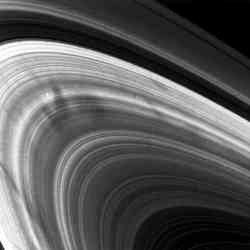
Spoke features in Saturn’s B-ring captured by Voyager 2 in August 1981. Image credit: NASA Click to enlarge
When Voyager first visited Saturn 26 years ago, it returned photographs of unusual spokelike structures in the rings. The Hubble Space Telescope confirmed the spokes in the 1990s, but then they faded out. It’s believed that the spokes are caused when electrically charged particles collect above the surface of the rings, scattering light from the Sun differently than the rings themselves. Scientists think they might be due to return around July this year, as they depend on the ring’s angle towards the Sun, which is now decreasing.
Unusual spokes that appear fleetingly on the rings of Saturn only to disappear for years at a time may become visible again by July, according to a new study spearheaded by the University of Colorado at Boulder.
The spokes, which are up to 6,000 miles long and 1,500 miles in width, were first spotted 26 years ago by the Voyager spacecraft, said CU-Boulder Professor Mihaly Horanyi of the Laboratory for Atmospheric and Space Physics. But when the Cassini spacecraft arrived at Saturn in July of 2004, the striking radial features that cut across Saturn’s ring plane were nowhere to be found — an event that disappointed and puzzled many scientists, he said.
The Hubble Space Telescope occasionally observed the ring spokes in the late 1990s, said Horanyi, a professor of physics at CU-Boulder. But the spokes gradually faded, a result of Saturn’s seasonal, orbital motion and its tilted axis of rotation that altered the light-scattering geometry.
“The spokes were switched off by the time Cassini arrived,” said Horanyi. “We think it is a seasonal phenomena related to the sun rising and setting over the ring plane that changes the physical environment there, making it either friendly or hostile to their formation.”
A paper on the subject appears in the March 17 issue of Science magazine. The paper was authored by doctoral student Colin Mitchell and Horanyi of CU-Boulder’s LASP, Ove Havnes of the University of Trosmo in Norway and Carolyn Porco of the Space Science Institute in Boulder.
The spokes are made up of tiny dust particles less than a micron in width — about 1/50th the width of a human hair — that collect electrostatic charges in the plasma environment of the rings and become subject to electrical and magnetic forces, said Horanyi. The right conditions cause them to gain an extra electron, allowing them to leap en masse from the surface of ring debris for brief periods, collectively forming the giant spokes that appear dark against the lit side of the rings and bright against the unlit side of the rings.
The researchers hypothesize that the conditions for the spokes to form are correlated to a decrease in the angle of the ring plane to the sun. “Because the rings are more open to the sun now than when Voyager flew by, the charging environment above the rings has prevented the formation of the spokes until very recently,” the researchers wrote in Science.
Cassini first imaged a “puny version” of Saturn’s spoke rings from a distance of 98,000 miles in early September that were only about 2,200 miles in length and about 60 miles wide, said Horanyi. The team believes the spoke sighting may have been an “early bird” event.
As the ring plane angle decreases when Saturn is near its two seasonal equinoxes, the conditions appear to become more suitable for the formation of the eerie spokes, said Horanyi. Although Cassini currently is orbiting too close to the ring plane to make observations, the researchers expect the spoke activity to have returned by the time the spacecraft increases its inclination in July 2006.
Once the spokes are visible again, the research team believes there will be spoke activity for about eight years, based on the fact that it takes Saturn about 30 Earth-years to complete one orbit around the sun, said Horanyi. The eight-year period should be followed by about six-to-seven years of a spoke hiatus, he said.
The dust grains levitated by plasma during spoke-forming periods are probably hovering less than 50 miles above the rings themselves and they scatter light from the sun differently than do the rings themselves, he said.
But there are still many questions about the spokes, said Horanyi. “We don’t know if they form by rapidly expanding, or if they form all at once,” he said. During the Voyager mission, they were absent during one observation, but fully developed in a follow-up observation made just five minutes later, Horanyi said.
“This is a weird phenomena; we don’t have the full story on it yet,” he said.
Original Source: CU-Boulder News Release
March 29 Total Eclipse
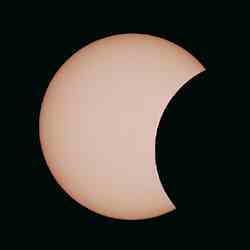
Partial solar eclipse across the United States on May 10, 1994. Image credit: Sky & Telescope Click to enlarge
Those lucky enough to live in parts of Africa, Turkey and Central Asia will experience a total eclipse of the Sun on Wednesday, March 29, 2006. Even larger areas of the Earth will get to see the Sun dim in a partial solar eclipse, from Brazil to China. If you’re lucky enough to be watching from the thin path of totality, the Sun will be completely obscured by the Moon, making the corona visible like a fiery ring.
On Wednesday, March 29, 2006, a total eclipse of the Sun will sweep across parts of West and North Africa, Turkey, and Central Asia. The eclipse will be partial across a much wider region, including most of Africa, all of Europe, and much of western and southern Asia.
The accompanying maps provided by Sky & Telescope magazine tell the story. They will help skywatchers in those regions of the world to plan their activities for the big day.
A solar eclipse happens when the Moon crosses the face of the Sun as seen from your viewpoint on Earth. The globe map shows the entire region of Earth that will be touched by any part of this eclipse, including the complete path of totality: where the Sun will become completely covered by the Moon. As the map shows, the total eclipse starts at sunrise at the tip of Brazil, crosses the Atlantic in the morning, the Sahara Desert at midday, Turkey in the afternoon, and ends at sunset in Central Asia. Red lines on the globe map indicate how much of the Sun’s diameter is covered at maximum partial eclipse. Purple lines tell when this happens, in Universal Time (UT; also called Greenwich Mean Time or GMT).
The close-up map of Europe and the Middle East gives more detail. Here, blue and red lines tell the start and end times of partial eclipse, respectively, again in UT/GMT. The partial eclipse for any site is at its maximum halfway between these times. The black lines on the map tell the percentage of the Sun’s diameter that will be covered at maximum eclipse.
Although a partial solar eclipse can’t hold a candle to a total one, it’s a memorable celestial event in its own right. Can you see a change in the illumination of the landscape around you? A partial eclipse has to be surprisingly deep to alter the light visibly, because our eyes are very good at adjusting to ambient light levels. But when this does happen, the world seems to take on an odd, silvery feel like no other. Look for crescent-shaped dapplings on the ground where sunlight shines through leaves. In a safely solar-filtered telescope (see below), look for mountain silhouettes on the Moon’s dark edge. Look too for a difference between the Moon’s complete darkness and the not-so-complete darkness of any sunspots that the edge of the Moon approaches.
Warning: Never look at the bright surface of the Sun without proper eye protection! Examples are special “eclipse glasses” properly designed for the purpose, a #14 rectangular arc-welder’s filter, or special astronomers’ solar filters (see our list of solar filter suppliers). Staring at the bright Sun can burn your retina, leaving a permanent blind spot in the center of your vision. The only reason a partial eclipse poses a special danger is because it can prompt people to look directly at the Sun, something they wouldn’t normally do. See our complete descriptions of the various ways to watch safely, including the “projection method” using a pinhole, binoculars, or a telescope.
Looking while the Sun is totally eclipsed, on the other hand, is safe. At that time, of course, none of the Sun’s bright surface is in view.
People who’ve never tried photographing a solar eclipse before can get fine results by following Sky & Telescope’s tips for photographers.
More on this particular eclipse appears in the January and March 2006 issues of Sky & Telescope, the Essential Magazine of Astronomy.
For detailed local predictions at any given location, please see NASA’s Web site for this eclipse.
Original Source: Sky and Telescope
